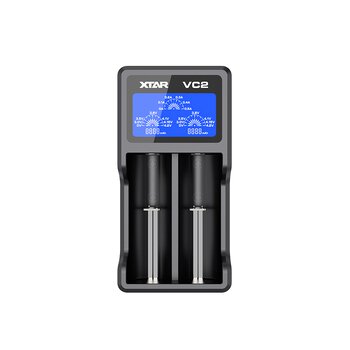Professional dual-Channel compact processor charger VC2 is a professional processor loader with three-stage charging process TC/CC/CV and LCD display. It charges 1-2 Li-ion 3.6/3.7 V cells with any capacity in sizes 10440, 14500, 14650, 16340, 17500, 17670, 18350, 18500, 18650, 18700, 20700, 21700, 22650, 25500, 26650.
Xtar VC2
For Li-ion batteries in 18650 sizes and other
• Two independent charging channels
• LCD display for link voltage and charging current
• Informs about the current used to charge-the ability to measure the capacity of the cell (measurement error ± 5%)
• Powered by any micro USB charger or USB port on your computer
• Compact size-Easy to carry
• Reactivation function of deeply discharged cells
• Protection: Short-circuit, thermal, reverse polarity
The illuminated LCD display of the charger Xtar VC2 shows up to date the status of the charger: the voltage of the batteries charged, the charging current, the load used to charge the cells, indicates. Errors and informs you that the charging is complete. Information on the load used can be used to measure the capacity of the batteries. To measure the capacity of the battery, it must be discharged to the appropriate voltage cut-off level (usually 2, 5V) and inserted into the charger VC2. When charging is complete, you can read the value of the charge used to charge the battery. This will Always be a value of 3-5% higher than the actual battery capacity. Due to the fact that the charging process of batteries is never in 100% efficient, ie. A slightly larger load is needed to charge the battery than the actual cell capacity is.
What Is THE TC/CC/CV charging method? It is a three-step process of loading Li-ion cells to keep the cell in good condition by charging the right current at each stage and completing the charging process at the right moment.
The various stages of the TC/CC/CV process are:
• TC phase: Cells discharged below 2, 9V are ' awake ' to lower currents.
• CC phase: When 2, 9V is reached, the cell is loaded with a constant current of 0, 05A to 0, 5A (depending on the power source being used).
• CV phase: When the cell is already nearly charged, the charger switches to a decreasing current charge until it reaches a voltage of 4, 2V on the cell. After reaching 4, 2V the charging process is complete-the battery is fully charged.
When left in the charger, the charged batteries will be subjected to a natural self-discharge process. Charging will resume when the battery voltage drops below 3.9 v.
The Xtar VC2 Charger has a function of reactivating deeply discharged cells and cells with a Voltage Of 0v. Many chargers on the market are not able to charge such batteries. Here with the help comes the charger Xtar VC2, which in many cases allows you to ' resave ' such cells. Just insert a deeply discharged battery into the VC2 charger, as with normal charging, the charger detects the unloaded link and attempts to reactivate it. Attention! Cells unloaded below a certain level are irreversible and reactivated may not be possible. Avoid too deep discharge of Li-ion batteries-this can lead to a significant reduction in their durability and capacity or
Supplied with the Xtar VC2 charger, we get a micro USB cable and a cover for securing the charger for transport. The power supply is not Included In the set. Any charger with a micro USB cable, for example, is enough to power the charger. Phone, or USB port or a computer with a free USB socket. The recommended charger power is 2A (2000mA).
| Product data | |
| Manufacturer | Xtar |
| Charger Model | Vc2 |
| Supported Battery types | 1-2 Rechargeable Li-Ion 3.6 batteries-3, 7V, secured and unprotected |
| Supported Battery Sizes | 10440, 14500, 14650, 16340, 17500.17670, 18350, 18500, 18650, 18700, 20700, 21700, 22650, 25500, 26650 |
| Maximum battery length | 70mm |
| Charging method | Processor-controlled TC/CC/CV |
| Charging In the CC phase | 50-500mA Depending on the power source being used |
| End Voltage Loading | 4, 2V ± 0, 05V |
| Current of terminations | < 80mA |
| LCD Display functions | Current indications: Operating/Charging status Charging Battery voltage The load used to charge the cells |
| Additional functions | Reactivation of deeply discharged cells and cells 0V Cell capacity measurement (accuracy ± 5%) |
| Security | Thermal Short Circuit Before the battery is reversed |
| Input voltage and Input current | 5V 1000mA |
| Power connector | Micro USB |
| Power supply included | Not |
| Recommended power supply | Minimum 5V 1A, recommended 5V 2A |
| Dimensions | 131 x 66 x 33mm |
Micro USB Cable,
Cover
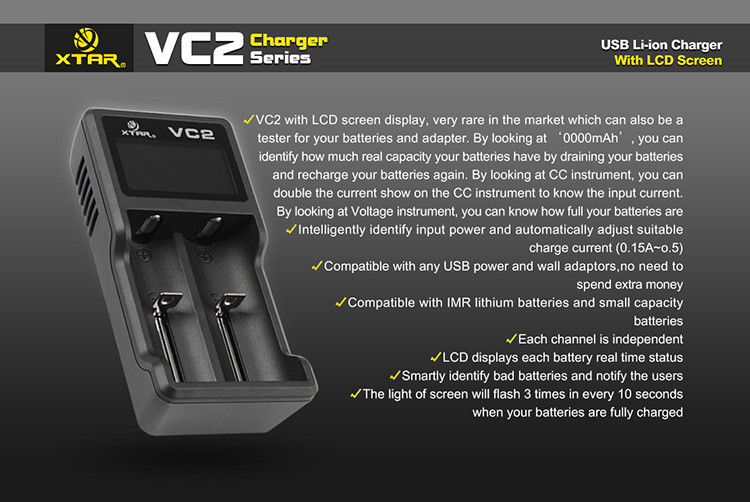
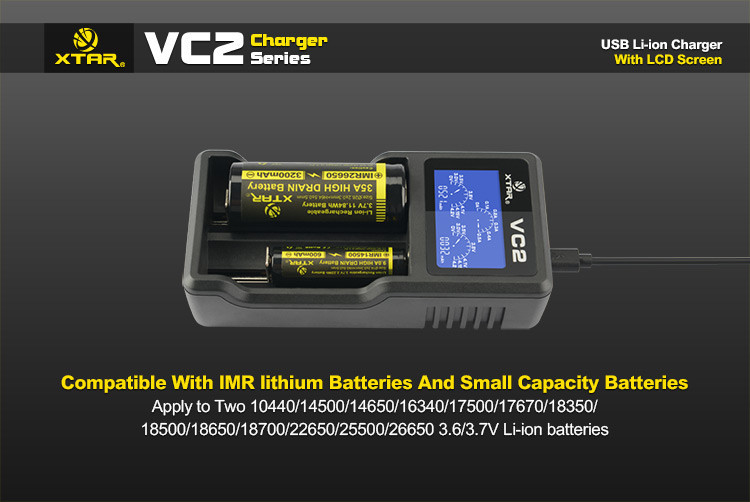
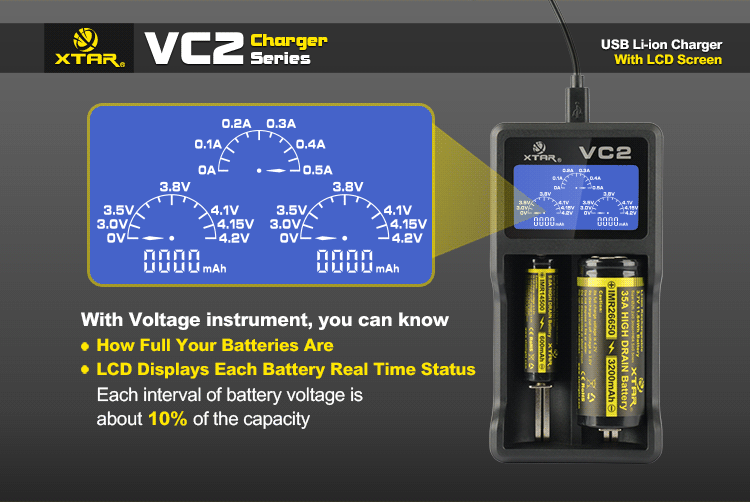
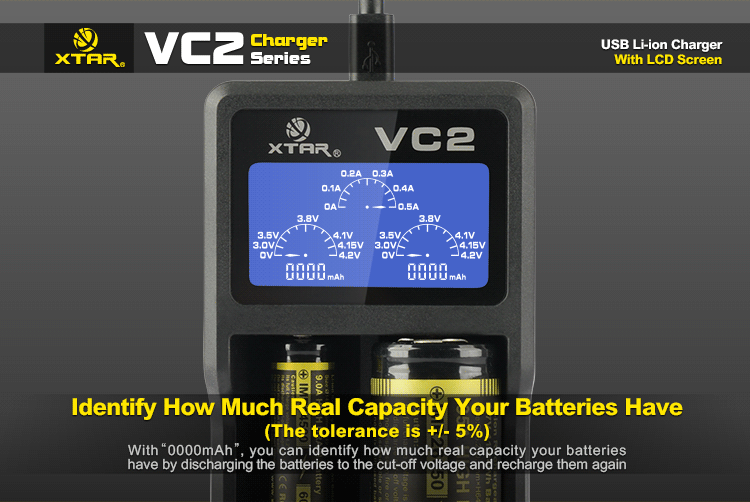
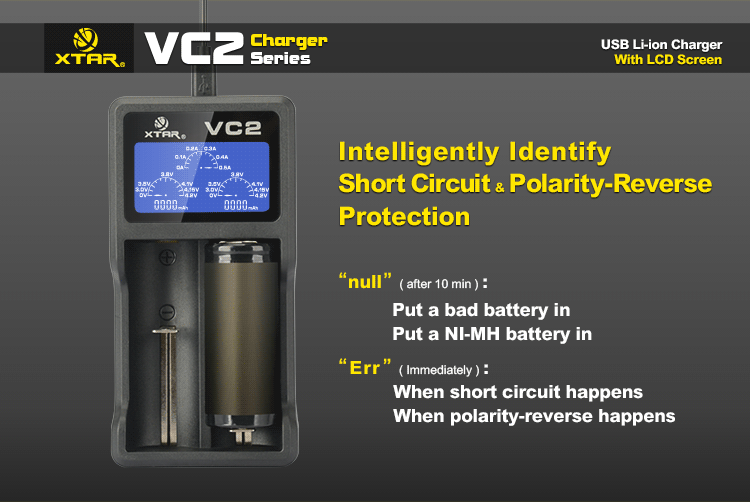
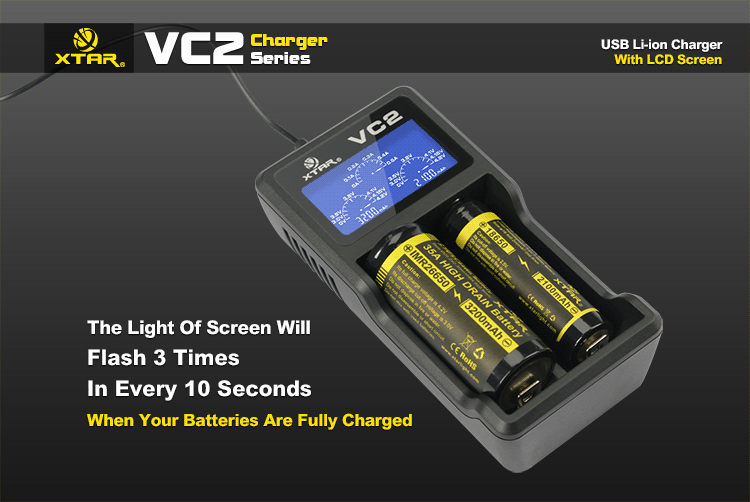
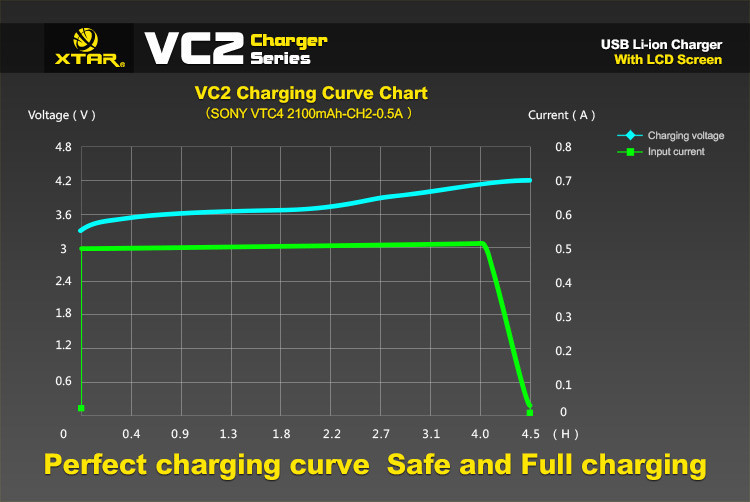
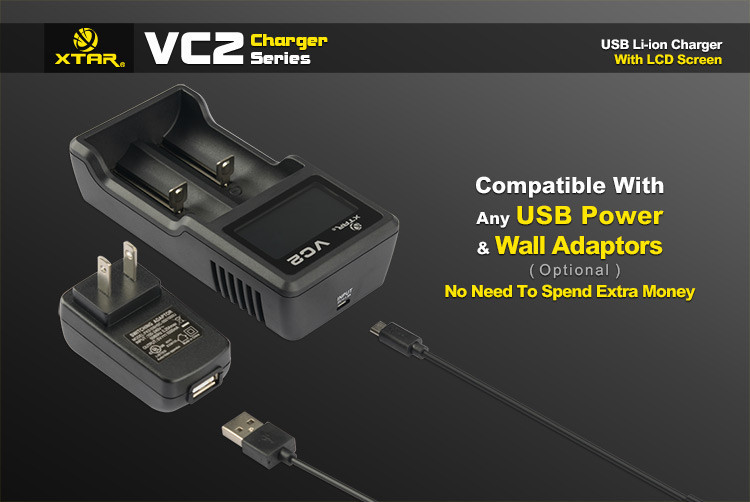
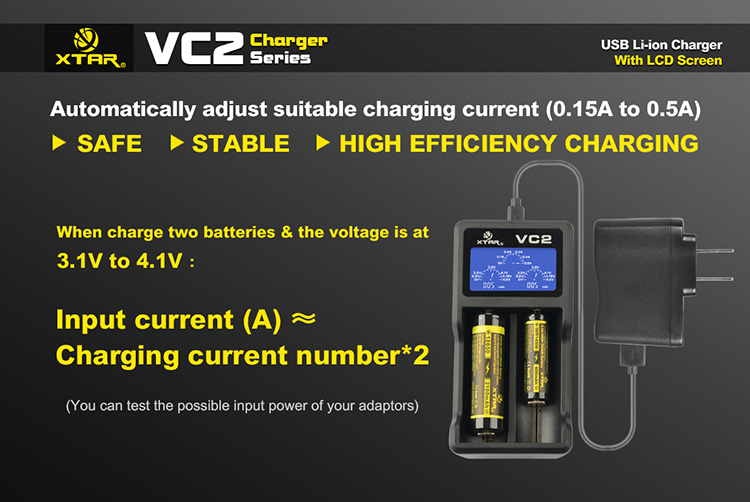
Produkt posiada oznaczenie CE.
- Li-ion batteries 3.6-3.7V, unprotected
- Li-ion batteries 3.6-3.7V, protected (with PCM/PCB)
- 5 V DC / 1000 mA(Kabel micro USB w zestawie)
- Processor-controlled TC/CC/CV for Li-ion
- 50-500mA depending on the power source used
- 4.2V ±0.05V
- Reactivation of deeply discharged cells and 0V cells
- Cell capacity measurement (accuracy ±5%)
- Before the charger overheats
- Against overload / short circuit
- Before reverse polarity of cells
- Charge
- Working/Charging Status
- Charging
- Battery voltage
- Charge used to charge the cells
- VC2 charger
- Micro USB cable
- Li-ion batteries 3.6-3.7V, unprotected
- Li-ion batteries 3.6-3.7V, protected (with PCM/PCB)
- 5 V DC / 1000 mA(Kabel micro USB w zestawie)
- Processor-controlled TC/CC/CV for Li-ion
- 50-500mA depending on the power source used
- 4.2V ±0.05V
- Reactivation of deeply discharged cells and 0V cells
- Cell capacity measurement (accuracy ±5%)
- Before the charger overheats
- Against overload / short circuit
- Before reverse polarity of cells
- Charge
- Working/Charging Status
- Charging
- Battery voltage
- Charge used to charge the cells
- VC2 charger
- Micro USB cable
